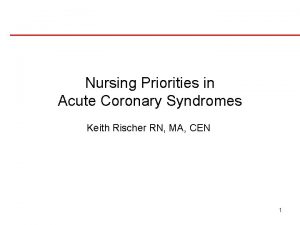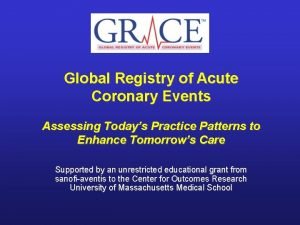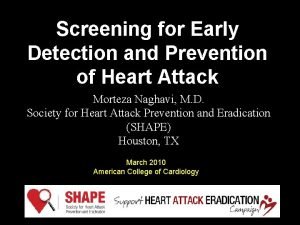Raigmore Critical Care Guidelines Acute coronary syndrome in


- Slides: 2

Raigmore Critical Care Guidelines Acute coronary syndrome in Critical Care Aim To provide guidance on risk stratification and initial management of suspected acute coronary syndrome in critical care Scope All critically ill adult patients with suspected ACS Suspected Acute Coronary Syndrome (ACS) in Critical Care Unlikely primary cardiac cause for overall critical illness Likely or definite primary cardiac cause for overall critical illness Are new ECG changes present? • ST elevation • T wave inversion • ST depression • LBBB Are any of these features present? • VF or VT • ST elevation >1 mm • ST elevation >2 mm Treat as non-ACS Are there other more likely causes for these ECG changes? e. g. PE, sepsis, stress-induced cardiomyopathy, hypoxaemia • Treat other possible underlying causes • Keep monitoring for features of ACS Treat as ACS • Emergency cardiology review • Consider dual anti-platelet therapy Consider clinical status and risk factors Change in Clinical Status New pulmonary oedema Ne cardiac murmur or mitral regurgitation 3 rd heart sound New haemodynamic compromise New arrhythmia Low Risk • No change in clinical status • No risk factors • Check troponin twice (12 hrs apart) • Monitor for ECG changes Coronary Artery disease risk Factors Known IHD Older age Recent history suggestive of undiagnosed angina diabetes, smoking or peripheral vascular disease hypertension or family history of heart disease Intermediate Risk Either change in clinical status or risk factors present • Transthoracic echo • Serial troponin twice (3, 6, 12 hrs) • Monitor for ECG changes • If dynamic ECG changes; Q waves; raised troponin; or new regional wall motion abnormality, treat as high risk Adapted from Queen Alexandra hospital Portsmouth – M Mac. Kinnon 30. 11. 2016 high Risk • No change in clinical status • No risk factors • Get urgent cardiology review • Consider starting dual anti-platelet therapy.

Raigmore Critical Care Guidelines Administration of thrombolytic therapy. Tenecteplase dosing regime Body weight (kg) <60 60 - <70 70 - <80 80 - <90 >90 Tenecteplase (u) 6, 000 7, 000 8, 000 9, 000 10, 000 Tenecteplase (mg) 30 35 40 45 50 Absolute contra-indications to thrombolytic therapy. Relative contra-indications to thrombolytic therapy. Adapted from Queen Alexandra hospital Portsmouth – M Mac. Kinnon 30. 11. 2016 Volume (ml) 6 7 8 9 10



